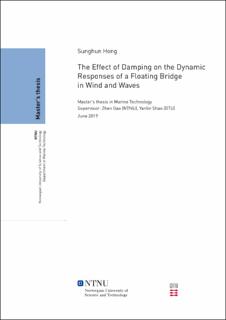| dc.description.abstract | The Norwegian Public Roads Administration is working on The E39 Coastal Highway Route project to reduce the travel time of 21 hours between Trondheim and Kristiansand to 11 hours by replacing seven fjord ferry connections with bridges and tunnels. The cable-stayed curved floating design has been proposed to cross Bjørnafjorden. Since the design is a long curved structure of 5 $km$ supported by 19 pontoons without side mooring under wind and waves combined environment, the complex resonance response in different natural periods is a challenge. Damping plays an important role in reducing the resonance response in such a harsh environment. Therefore, the main purpose of this study is to investigate various damping effects on the global dynamic response of floating bridges. The 100-year wave conditions are modeled by the JONSWAP spectrum with directional function and the 100-year wind field is generated by TurbSim with Kaimal spectrum. SIMO-RIFLEX is used in numerical simulations. The heave response without the viscous effect was 0.2-0.5 $m$. The viscous damping for the heave motion is modeled by the $KC$ dependent drag coefficient, and the obtained value is 23.98, which corresponds to 8.3 for the conventional drag coefficient. After the free decay test, it was found that the linearized viscous damping ratio for the heave motion is 1.49 \%, while the total damping is 6.81 \%. Since the heave motion is small, the viscous effect is not significant. As a result of analyzing the stresses of the bridges, it was found that the total bridge girder stress is mainly due to the static stress. The static stress is governed by the weak axis bending moment which is mainly induced by the bridge weight and buoyancy. Since the static effect is predominant in the given bridge design, the damping effects are not noticeable. For the horizontal motion of pontoons, a wave drift damping can be investigated for the future study. However, prior to improving damping for the dynamic effect on the bridge, it is necessary to increase the number of pontoons to reduce the bending moment about the weak axis and reduce the overall static effect. | |

